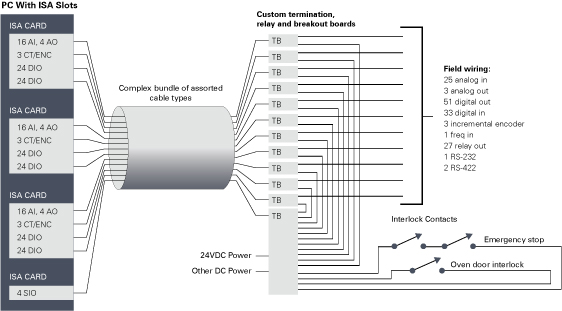| The Future of Industrial I/O | ||||||||||||||||||||||||||||||||||||||||||||||||||
|---|---|---|---|---|---|---|---|---|---|---|---|---|---|---|---|---|---|---|---|---|---|---|---|---|---|---|---|---|---|---|---|---|---|---|---|---|---|---|---|---|---|---|---|---|---|---|---|---|---|---|
| Industrial I/O devices form the nervous systems of many modern machines. Several widely used I/O strategies exist; some are newer and others are, for the most part, remnants of an earlier technology era. Below, a brief list of popular strategies illustrates this diversity. |

|
|||||||||||||||||||||||||||||||||||||||||||||||||
Popular StrategiesHost-resident I/O boards plug into a host computer's expansion slots. Examples of this are PCI Express and PC/104+ cards.
RS-232 ports interface to devices such as bar code scanners and PTZ cameras.
RS-422/RS-485 ports are most often used for small networks of simple devices.
The Modern Approach: EthernetEthernet offers powerful advantages for all but the most trivial I/O systems (IOS). It is electrically isolated so that pesky ground loops are eliminated. A single, standardized cable connects the controller to the IOS. The IOS can be located far from its controller and, in many cases, can be distributed. Field wiring connects directly to the remote IOS, so termination boards are not needed. Ethernet is fast: it runs circles around RS-232, RS-422 and RS-485. Also, Ethernet's network (IP) and transport (TCP/UDP) protocol layers are widely used standards. Additional computers can be connected to an Ethernet in seconds, enabling multiple hosts to monitor and control the IOS. Perhaps most importantly, Ethernet offers protection from platform obsolescence. Ethernet is available for virtually every hardware platform in existence, and it will continue to be available for the foreseeable future. A comparison of popular I/O strategies
Implementation EnigmaModern IOS suppliers have seen the writing on the wall, and there are now nearly as many Ethernet IOS architectures as vendors. When transitioning to Ethernet I/O, designers must assess a wide range of features. Consider the following Ethernet IOS architectures: Ethernet Per Module systems have an integral Ethernet interface on every I/O module.
Module Carrier systems. The Ethernet interface is often supplied as a plug-in module. I/O interface plug-ins are affixed to the carrier as required.
Star Cluster systems utilize an Ethernet module that serves as a gateway to satellite I/O modules. Standardized cables connect the gateway to its satellites in a star configuration.
Essential FeaturesAside from its architecture, every Ethernet IOS has important functional features that must be evaluated. Every industrial IOS must provide some level of support for the following common functions:
Case StudyFor years, a major manufacturer of automated soldering systems had employed ISA I/O cards in a PC-compatible host computer (Figure 1). From the very beginning they were plagued with the classic problems of host-resident I/O. The mass of cables emerging from the host was a maintenance nightmare. Frustrating ground-loop problems flared up regularly. Miles of wiring and custom termination systems translated into high material and assembly costs. The final straw came with the demise of ISA. It was time for a new approach. Figure 1: The original IOS using host-resident I/O
The Path to ModernizationEthernet was the obvious answer because it offered sound solutions for the most severe problems. Never again would there be a hardware platform dependency. Wiring costs would be minimized with remote, distributed I/O. Ground loop issues would be reduced to a manageable level. After deciding upon Ethernet, the next step was choosing an IOS architecture. Aside from the required technical merits, cost was a primary concern due to extreme competitive pressures. This quickly ruled out Ethernet Per Module because of its high cost. Since this application had a high number of I/O points, the Module Carrier architecture was also ruled out as its "sweet spot" is restricted to single-carrier systems. The optimal solution, in terms of both cost and complexity, turned out to be a Star Cluster system. A Concrete SolutionIn this case, the manufacturer selected Sensoray's Model 2600 Industrial I/O System (Figure 2). This star cluster system inherently solved the formidable problems of ground loops and platform obsolescence. Component costs were greatly reduced. Power monitors and multiple RS-232/RS-422 ports are built into the gateway module, so satellite modules were not needed for those functions. Built-in support for interlock circuits and power distribution minimized the need for external terminal blocks. Modules connected together easily with standard Category-5 patch cables. These are readily available, low-cost commodity items. All field wiring connected via quick-change connectors. And although this IOS offers all the advantages of a distributed I/O architecture, its optically isolated inter-module communication interfaces eliminated the risk of associated ground loops. In the end, this manufacturer realized significant reductions in manufacturing and maintenance costs by upgrading to an Ethernet IOS, while at the same time eliminating the serious problems that had afflicted previous generations of soldering machines. Figure 2: The new Ethernet I/O system
|
||||||||||||||||||||||||||||||||||||||||||||||||||



